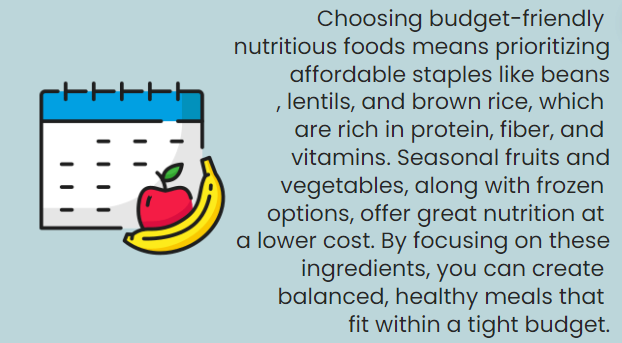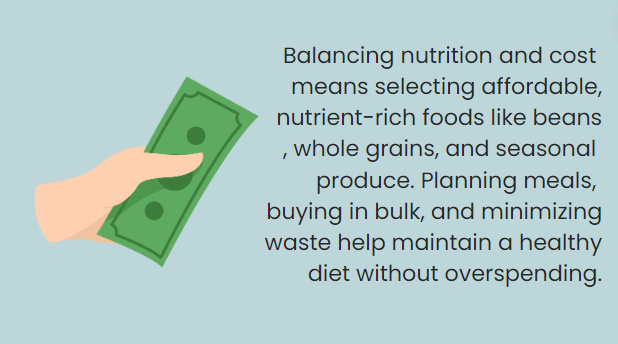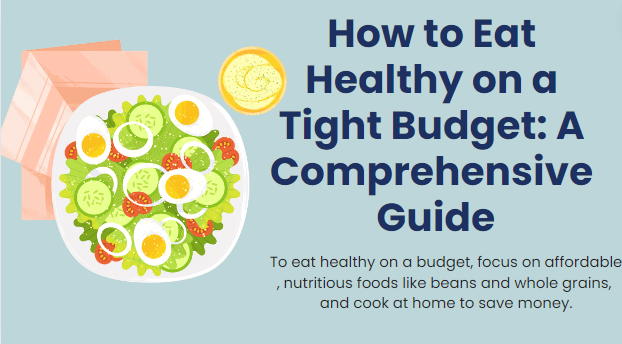Eating healthy doesn’t have to break the bank. With smart planning and strategic shopping, you can nourish your body without emptying your wallet. This guide will show you how to make nutritious choices while sticking to a tight budget.
Understanding the Basics of Healthy Eating
Before diving into budget-friendly strategies, it’s essential to understand what constitutes a healthy diet:
- Variety: Eat a wide range of foods from all food groups
- Balance: Consume appropriate portions of different foods
- Moderation: Avoid excessive intake of any single food or nutrient
- Nutrient density: Choose foods that provide maximum nutrients for minimal calories
A balanced diet should include:
- Fruits and vegetables
- Whole grains
- Lean proteins
- Healthy fats
- Low-fat dairy or dairy alternatives
Planning Your Meals
Meal planning is crucial for eating healthy on a budget. Here’s how to get started:
- Set aside time each week for meal planning
- Check your pantry and refrigerator for ingredients you already have
- Plan meals around sales and seasonal produce
- Create a shopping list based on your meal plan
- Stick to your list when shopping to avoid impulse purchases
Sample Weekly Meal Plan
| Day | Breakfast | Lunch | Dinner |
|---|---|---|---|
| Monday | Oatmeal with fruit | Lentil soup and salad | Baked chicken with vegetables |
| Tuesday | Whole grain toast with egg | Tuna salad sandwich | Vegetable stir-fry with rice |
| Wednesday | Greek yogurt with berries | Leftover lentil soup | Bean and cheese quesadillas |
| Thursday | Breakfast burrito | Chickpea salad | Spaghetti with tomato sauce |
| Friday | Banana smoothie | Peanut butter sandwich | Baked fish with sweet potato |
Smart Shopping Strategies
Implement these strategies to maximize your grocery budget:
- Compare prices between stores
- Use coupons and loyalty programs
- Buy generic or store-brand products
- Purchase in bulk for non-perishable items
- Shop the perimeter of the store first (where fresh foods are usually located)
- Check unit prices to ensure you’re getting the best deal
- Shop at local farmers’ markets for fresh, seasonal produce
- Consider joining a community-supported agriculture (CSA) program
Choosing Budget-Friendly Nutritious Foods
Focus on these affordable, nutrient-dense foods:
- Legumes (beans, lentils, peas)
- Whole grains (brown rice, oats, quinoa, barley)
- Eggs
- Frozen fruits and vegetables
- Canned fish (tuna, sardines, mackerel)
- In-season produce
- Potatoes and sweet potatoes
- Whole chicken
- Cheaper cuts of meat (when used in moderation)
- Seeds and nuts (bought in bulk)
Nutrient-Dense Budget Foods Comparison
| Food Item | Price per Serving* | Key Nutrients |
|---|---|---|
| Lentils | $0.15 | Protein, fiber, iron, folate |
| Brown rice | $0.10 | Fiber, manganese, magnesium |
| Eggs | $0.25 | Protein, vitamin D, choline |
| Frozen spinach | $0.30 | Vitamin A, vitamin C, iron, calcium |
| Canned sardines | $0.50 | Omega-3 fatty acids, protein, calcium |
*Prices are approximate and may vary by location

Money-Saving Cooking Techniques
Adopt these cooking methods to stretch your food budget:
- Batch cooking: Prepare large quantities and freeze portions for later
- Use a slow cooker: Turn inexpensive cuts of meat into tender meals
- Repurpose leftovers: Transform tonight’s dinner into tomorrow’s lunch
- Make your own sauces and dressings: Avoid expensive pre-made options
- Grow your own herbs: Save money on fresh herbs and add flavor to dishes
- Learn one-pot meals: Reduce ingredient costs and simplify cooking
- Master the art of soup-making: Create filling, nutritious meals with affordable ingredients
- Bake your own bread: Save money and control ingredients
Reducing Food Waste
Minimize waste to get the most out of your grocery budget:
- Store food properly to extend shelf life
- Use perishables before they spoil
- Freeze excess produce for future use
- Save vegetable scraps for homemade stock
- Learn to use all parts of ingredients (e.g., broccoli stems, carrot tops)
- Plan meals that use similar ingredients to avoid waste
- Understand expiration dates vs. “best by” dates
- Compost inedible food scraps to reduce waste and benefit your garden
Making Smart Choices When Eating Out
While eating at home is generally more budget-friendly, there are ways to make healthier choices when dining out:
- Look for restaurants with budget-friendly options
- Split entrees or take half home for another meal
- Drink water instead of sugary beverages
- Choose dishes with vegetables as the main component
- Avoid expensive add-ons and extras
- Take advantage of early bird specials or lunch menus
- Look for restaurant coupons or deals online
- Opt for appetizers or sides instead of full entrees
Comparison of Eating Out vs. Cooking at Home
| Meal | Restaurant Price | Homemade Price | Savings |
|---|---|---|---|
| Grilled chicken salad | $12 | $3.50 | $8.50 |
| Vegetable stir-fry | $10 | $2.75 | $7.25 |
| Whole grain pasta | $14 | $2.00 | $12.00 |
Balancing Nutrition and Cost
When trying to eat healthy on a budget, it’s important to prioritize nutrient-dense foods. Here are some tips to balance nutrition and cost:
- Focus on whole foods: They’re often cheaper and more nutritious than processed alternatives
- Incorporate plant-based proteins: Beans and lentils are cheaper than meat and provide essential nutrients
- Buy frozen produce: It’s often cheaper than fresh and just as nutritious
- Choose whole grains: They’re filling, nutritious, and often inexpensive
- Limit processed and packaged foods: They’re often expensive and less nutritious
- Use spices and herbs: They add flavor without extra calories or cost
- Stay hydrated with water: It’s free and essential for health

Building a Healthy Pantry on a Budget
A well-stocked pantry can help you create healthy meals even when money is tight. Here are some budget-friendly staples to keep on hand:
- Dried beans and lentils
- Brown rice and other whole grains
- Canned tomatoes
- Canned fish
- Pasta (preferably whole grain)
- Oats
- Nuts and seeds
- Olive oil
- Vinegar (for dressings and marinades)
- Dried herbs and spices
FAQs
Q: Can I really eat healthy on a tight budget?
A: Yes, with proper planning and smart shopping strategies, it’s possible to eat nutritious meals while keeping costs low.
Q: What are the most affordable sources of protein?
A: Legumes, eggs, canned fish, and whole chickens are excellent sources of protein that are typically budget-friendly.
Q: How can I save money on fruits and vegetables?
A: Buy seasonal produce, consider frozen options, and look for sales at your local grocery store or farmer’s market.
Q: Is it cheaper to cook at home or eat out?
A: Generally, cooking at home is significantly cheaper than eating out and allows for more control over ingredients and portion sizes.
Q: How can I make my groceries last longer?
A: Proper storage, meal planning, and using preservation techniques like freezing can help extend the life of your groceries and reduce waste.
Q: Are organic foods necessary for a healthy diet on a budget?
A: While organic foods can be beneficial, they’re not necessary for a healthy diet. Focus on eating a variety of fruits and vegetables, whether organic or conventional, to stay within your budget.
Q: How can I add variety to my meals without spending more?
A: Experiment with different spices and herbs, try new recipes using similar ingredients, and learn to prepare familiar ingredients in new ways.
Q: Is it possible to follow a special diet (e.g., vegan, gluten-free) on a tight budget?
A: Yes, but it may require more planning and creativity. Focus on whole foods that naturally fit your dietary needs and learn to make your own specialty items when possible.
Conclusion
Eating healthy on a tight budget is achievable with proper planning, smart shopping, and creative cooking. By focusing on nutrient-dense, affordable foods and adopting money-saving strategies, you can nourish your body without straining your finances. Remember that small changes can lead to significant improvements in both your health and your budget over time. With the tips and strategies outlined in this guide, you’re well-equipped to start your journey towards healthier eating on a budget.
